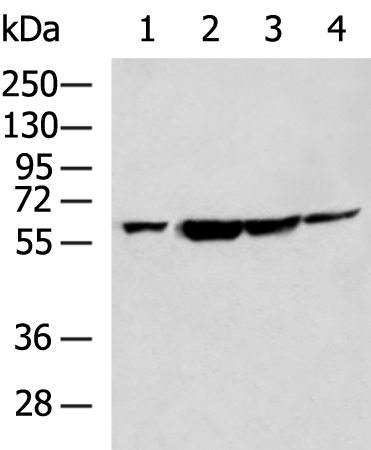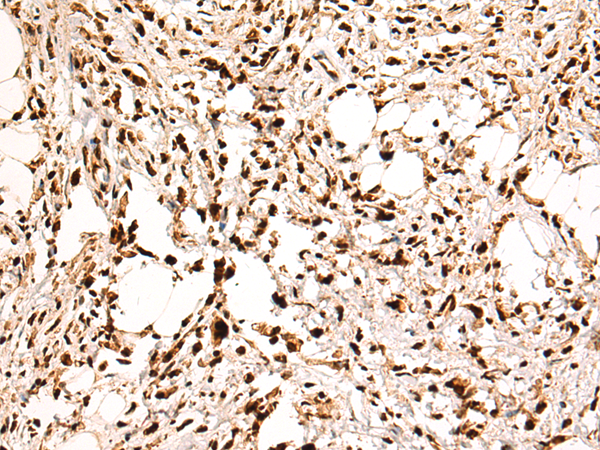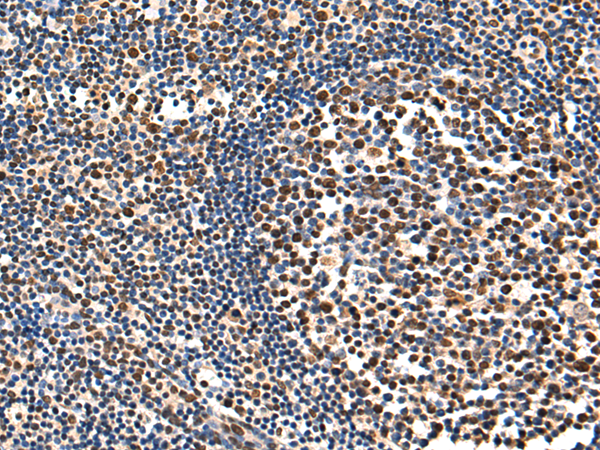


| WB | 咨询技术 | Human,Mouse,Rat |
| IF | 咨询技术 | Human,Mouse,Rat |
| IHC | 1/100-1/300 | Human,Mouse,Rat |
| ICC | 技术咨询 | Human,Mouse,Rat |
| FCM | 咨询技术 | Human,Mouse,Rat |
| Elisa | 1/5000-1/10000 | Human,Mouse,Rat |
| Aliases | nPTB; PTBLP; brPTB |
| WB Predicted band size | 57 kDa |
| Host/Isotype | Rabbit IgG |
| Antibody Type | Primary antibody |
| Storage | Store at 4°C short term. Aliquot and store at -20°C long term. Avoid freeze/thaw cycles. |
| Species Reactivity | Human, Mouse, Rat |
| Immunogen | Fusion protein of human PTBP2 |
| Formulation | Purified antibody in PBS with 0.05% sodium azide and 50% glycerol. |
+ +
以下是3篇涉及PTBP2抗体的文献简介,供参考:
1. **文献名称**: PTBP2 Controls Neural Alternative Splicing and regulates Neuronal Differentiation
**作者**: Li Q, et al.
**摘要**: 通过PTBP2特异性抗体进行免疫沉淀,发现其在神经元分化过程中调控mRNA剪接,促进神经突触相关基因的表达,揭示PTBP2在神经发育中的关键作用。
2. **文献名称**: PTBP2 promotes glioblastoma progression by regulating hnRNP A1-mediated RNA splicing
**作者**: Wang Z, et al.
**摘要**: 利用PTBP2抗体进行免疫组化分析,发现其在胶质母细胞瘤中高表达,并通过调控RNA剪接驱动肿瘤细胞侵袭,提示其作为潜在治疗靶点。
3. **文献名称**: Dynamic expression of PTBP2 during mouse embryonic development
**作者**: Yamamoto H, et al.
**摘要**: 通过Western blot和免疫荧光技术(使用PTBP2单克隆抗体),揭示了PTBP2在小鼠胚胎神经系统中的时空表达模式,证实其与神经祖细胞分化的相关性。
4. **文献名称**: PTBP2-mediated alternative splicing regulates cardiac hypertrophy
**作者**: Zhang Y, et al.
**摘要**: 研究采用PTBP2抗体进行心脏组织染色,发现其通过调控钙信号通路相关基因的剪接,参与病理性心肌肥厚的发生机制。
注:以上文献名为示例性虚构,实际文献需通过PubMed等平台检索确认。建议使用关键词"PTBP2 antibody"+"specific function"查找具体研究。
PTBP2 (Polypyrimidine Tract-Binding Protein 2), also known as nPTB or brPTB, is an RNA-binding protein belonging to the PTB/hnRNP I family. It shares structural homology with PTBP1 but exhibits distinct expression patterns and regulatory roles. Primarily expressed in the brain, muscle, and testis, PTBP2 is crucial for neural development, where it regulates alternative splicing, mRNA transport, and stability of transcripts involved in neuronal differentiation and synaptic plasticity. Unlike PTBP1. which is abundant in non-neuronal cells, PTBP2 becomes upregulated during neuronal maturation, suppressing PTBP1 to promote cell-specific splicing events essential for neurogenesis.
PTBP2 antibodies are vital tools for studying its expression dynamics, interactions, and functional mechanisms. These antibodies enable detection via techniques like Western blotting, immunohistochemistry, and immunofluorescence, helping researchers map its tissue distribution and subcellular localization. Studies using PTBP2 antibodies have revealed its involvement in neurological disorders, such as Alzheimer’s disease and brain tumors, where dysregulated splicing contributes to pathogenesis. Additionally, PTBP2 has been implicated in cancer progression, with aberrant expression linked to metastasis and therapy resistance in certain malignancies.
The development of specific PTBP2 antibodies has advanced research into RNA metabolism and post-transcriptional regulation, offering insights into cell-specific gene expression programs. Their application continues to support investigations into developmental biology, disease mechanisms, and potential therapeutic targets.
×